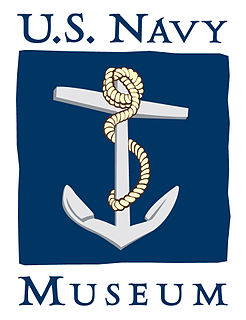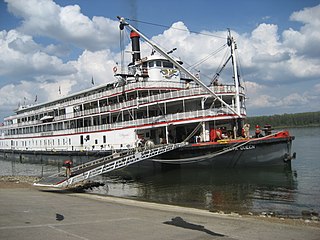Related Research Articles
Four ships of the United States Navy have been named USS Missouri in honor of the state of Missouri:

A steamboat is a boat that is propelled primarily by steam power, typically driving propellers or paddlewheels. Steamboats sometimes use the prefix designation SS, S.S. or S/S or PS ; however, these designations are most often used for steamships.
Four ships of the United States Navy have been named USS Indiana in honor of the 19th state.
Eight ships of the United States Navy and United States Revenue Cutter Service have been named USS Massachusetts, after the Commonwealth of Massachusetts.
Three ships of the United States Navy have been named for the 15th state:
Five ships of the United States Navy have been named USS Idaho in honor of the 43rd state.
USS Mississippi, named either for the state of Mississippi or the Mississippi River, may refer to:

A paddle steamer is a steamship or steamboat powered by a steam engine that drives paddle wheels to propel the craft through the water. In antiquity, paddle wheelers followed the development of poles, oars and sails, where the first uses were wheelers driven by animals or humans.
The New York Shipbuilding Corporation was an American shipbuilding company that operated from 1899 to 1968, ultimately completing more than 500 vessels for the U.S. Navy, the United States Merchant Marine, the United States Coast Guard, and other maritime concerns. At its peak during World War II, NYSB was the largest and most productive shipyard in the world. Its best-known vessels include the destroyer USS Reuben James (DD-245), the cruiser USS Indianapolis (CA-35), the aircraft carrier USS Kitty Hawk (CV-63), the nuclear-powered cargo ship NS Savannah, and a quartet of cargo-passenger liners nicknamed the Four Aces.
The names of commissioned ships of the United States Navy all start with USS, for United States Ship. Non-commissioned, primarily civilian-manned vessels of the U.S. Navy under the Military Sealift Command have names that begin with USNS, standing for United States Naval Ship. A letter-based hull classification symbol is used to designate a vessel's type. The names of ships are selected by the Secretary of the Navy. The names are those of states, cities, towns, important persons, important locations, famous battles, fish, and ideals. Usually, different types of ships have names originated from different types of sources.
Illinois is a state in the United States.

The National Museum of the United States Navy, or U.S. Navy Museum for short, is the flagship museum of the United States Navy and is located in the former Breech Mechanism Shop of the old Naval Gun Factory on the grounds of the Washington Navy Yard in Washington, D.C., United States.

Guy W. S. Castle was an officer of the United States Navy who received the Medal of Honor for his actions during the United States occupation, of Veracruz, Mexico, in 1914.

Steamboats played a major role in the 19th-century development of the Mississippi River and its tributaries, allowing practical large-scale transport of passengers and freight both up- and down-river. Using steam power, riverboats were developed during that time which could navigate in shallow waters as well as upriver against strong currents. After the development of railroads, passenger traffic gradually switched to this faster form of transportation, but steamboats continued to serve Mississippi River commerce into the early 20th century. A small number of steamboats are still used for tourist excursions in the 21st century.

The SteamboatIowa was revered as one of the largest and fastest boats on the Mississippi in the mid 19th century; it is incorporated into the official Seal of Iowa. Built in 1838, the Iowa was the first vessel named for the newly formed Territory of Iowa. It weighed 112 tons, could pull 10 keelboats, and it set the speed record from Galena, Illinois to St. Louis in 1843, making the trip in 44 hours, a record that held until 1849. The Iowa was hired by Mormon supporters of Joseph Smith, Jr. as part of a plan to rescue him from jail in June 1843; the excursion was cancelled after Smith was murdered in jail. The Iowa sank after a collision with the steamboat Declaration on Oct. 1, 1847 while traveling from New Orleans to St. Louis. This liability for this collision was ultimately decided by the U.S. Supreme Court case John Walsh v. Patrick Rogers. However, the Iowa was apparently rebuilt, or a new steamboat was later rechristened Iowa, since similar side-wheeler appeared twice in Barber and Howe's 1865 Loyal West in the Time of Rebellion, and there is reference to the Iowa being used as a troop transport during the Civil War.
Horace Ezra Bixby was a steamboat pilot on the Mississippi-Missouri-Ohio river system from the late 1840s until his death in 1912. Bixby is notable in his own right for his high standing in his profession, for his technical contributions to it, and for his service in the American Civil War. However, he is best known for having had as his "cub pilot" the young man known to him as Sam Clemens, later to become famous under his pen name as American author Mark Twain. Twain's descriptions of Bixby's character and pedagogic style form a good part of his memoir Life on the Mississippi, and it was through this medium that Bixby—much to his annoyance—became well-known beyond the circles of his family, friends and profession.
Verne Swain refers to three steamboats built by the Swain Shipyard of Stillwater, Minnesota. Swain built the first one in 1886, the second one in 1904, and the last one in 1913.
References
- ↑ "UW La Crosse Historic Steamboat Photographs".
- ↑ "UW La Crosse Historic Steamboat Photographs".
- ↑ US Dept. of Ag. Special report, Issue 34. 1881. p. 269.
- ↑ Harry Church Chappell, Katharyn Joella Allen Chappell (1914). History of Buchanan County, Iowa, and its people, Volume 1. pp. 590–591.